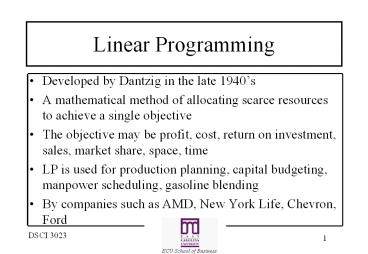Linear Programming - PowerPoint PPT Presentation
Title:
Linear Programming
Description:
Title: Linear Programming Author: Teacher Last modified by: John Kros Created Date: 1/26/1998 11:45:03 AM Document presentation format: A4 Paper Other titles – PowerPoint PPT presentation
Number of Views:129
Avg rating:3.0/5.0
Title: Linear Programming
1
Linear Programming
- Developed by Dantzig in the late 1940s
- A mathematical method of allocating scarce
resources to achieve a single objective - The objective may be profit, cost, return on
investment, sales, market share, space, time - LP is used for production planning, capital
budgeting, manpower scheduling, gasoline blending - By companies such as AMD, New York Life, Chevron,
Ford
2
Linear Programming
- Decision Variables
- symbols used to represent an item that can take
on any value (e.g., x1labor hours, x2 of
workers) - Parameters
- known constant values that are defined for each
problem (e.g., price of a unit, production
capacity) - Decision Variables and Parameters will be defined
for each unique problem
3
Linear Programming
- A method for solving linear mathematical models
- Linear Functions
- f(x) 5x 1
- g(x1, x2) x1 x2
- Non-linear functions
- f(x) 5x2 1
- g(x1, x2) x1x2 x2
4
Formulating an LP
- Define the decision variables
- identifying the key variables whose values we
wish to determine - Determine the objective function
- determine what we are trying to do
- Maximize profit, Minimize total cost
- Formulate the constraints
- determine the limitations of the decision
variables
5
3 Parts of a Linear Program
- Objective Function
- Constraints
- Non-negativity assumptions
6
3 Parts of a Linear Program
- Objective Function
- linear relationships of decision variables
describing the problems objective - always consists of maximizing or minimizing some
value - e.g., maximize Z profit, minimize Z cost
7
3 Parts of a Linear Program
- Constraints
- linear relationships of decision variables
representing restrictions or rules - e.g., limited resources like labor or capital
- Non-negativity assumptions
- restricts decision variables to values greater
than or equal to zero
8
Objective Function
- Always a Max or Min statement
- Maximize Profit
- Minimize Cost
- A linear function of decision variables
- Maximize Profit Z 3x1 5x2
- Minimize Cost Z 6x1 - 15x2
9
Constraints
- Constraints are restrictions on the problem
- total labor hours must be less than 50
- x1 must use less than 20 gallons of additive
- Defined as linear relationships
- total labor hours must be less than 50
- x1 x2 lt 50
- x1 must use less than 20 gallons of additive
- x1 lt 20
10
Non-negativity Assumptions
- Negative decision variables are inconceivable in
most LP problems - Minus 10 units of production or a negative
consumption make no sense - The assumptions are written as follows
- x1, x2 gt 0
11
LP Standard Form
- Each LP must contain the three parts
- A standard form for a LP is as follows
- Maximize Z c1x1 c2x2 ... cnxn
- subject to a11x1 a12x2 ... a1nxn lt b1
- .
- am1x1 am2x2 ... amnxn lt bm
- x1, x2, xn gt 0
12
Methods of Solving LP Problems
- Two basic solution approaches of linear
programming exist - The graphical Method
- simple, but limited to two decision variables
- The simplex method
- more complex, but solves multiple decision
variable problems
13
Graphical Method
- 1. Construct an x-y coordinate plane/graph
- 2. Plot all constraints on the plane/graph
- 3. Identify the feasible region dictated by the
constraints - 4. Identify the optimum solution by plotting a
series of objective functions over the feasible
region - 5. Determine the exact solution values of the
decision variables and the objective function at
the optimum solution

